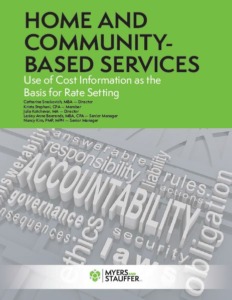In a series of posts, Myers and Stauffer will highlight home and community-based services (HCBS) and rate setting methodologies that can have a tremendous impact on services with state programs.
States often use cost surveys to evaluate current home and community-based services (HCBS) rates, and develop new methodologies to pay for HCBS. A cost-based approach is consistent with methodologies the state might use for other services, and it helps establish compliance with federal regulations regarding allowable cost principles. Providers also frequently reference their own costs in delivering services as they evaluate the adequacy of fee schedules.
After a state makes the decision to use a cost survey, with or without supplementation from other available data sources, there are several key steps to collect survey data effectively:
- Design a simple yet effective cost survey to capture data.
- Set reasonable timetables to develop the survey, collect data, and review the information.
- Allow service providers time to review and comment on the design of the cost survey and the instructions for completion, through work groups and other external stakeholder opportunities.
- Communicate with providers throughout the process: tell them we are developing a survey, explain use of the survey information, discuss the types of data being collected, and address other goals and objectives of the process.
- Schedule and hold cost survey completion training and follow up with providers through Question & Answer sessions.
- Consider implementing regulations to require the submission of cost surveys.
How We Can Help
The Centers for Medicare & Medicaid Services requires states to review their rates, at a minimum, every five years. Many states have leveraged ARPA Section 9817 dollars to develop innovative strategies to assist with their HCBS workforce challenges, including the implementation of provider rate surveys. Using ARPA funding, provider rate studies can create opportunities for states to understand their workforce needs and make necessary changes. Myers and Stauffer is currently helping clients implement rate reimbursement structures, and we have the expertise to develop provider-driven rate surveys as a tool in supporting a state’s HCBS provider workforce infrastructure.
To get additional insight into our approach to provider rate surveys, see the following article in the series, coming soon. For more information, please contact us.
For more information, please contact us.
| Krista Stephani, CPA
Member PH 208.685.1569 PH 800.336.7721 |
Lesley Beerends, MBA, CPA
Senior Manager PH 816.847.3280 PH 800.374.6858 |



